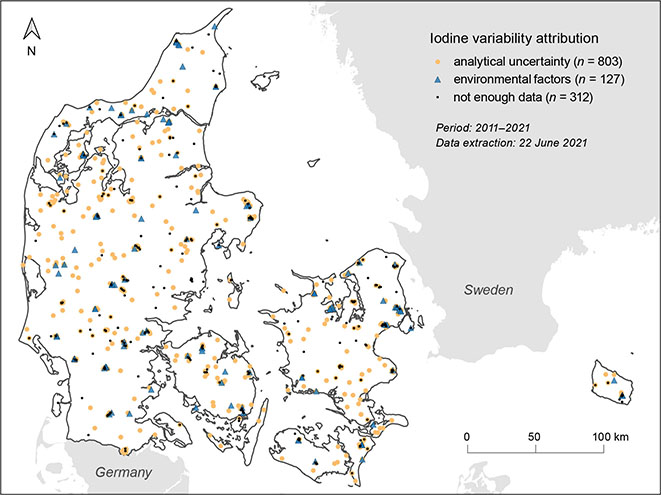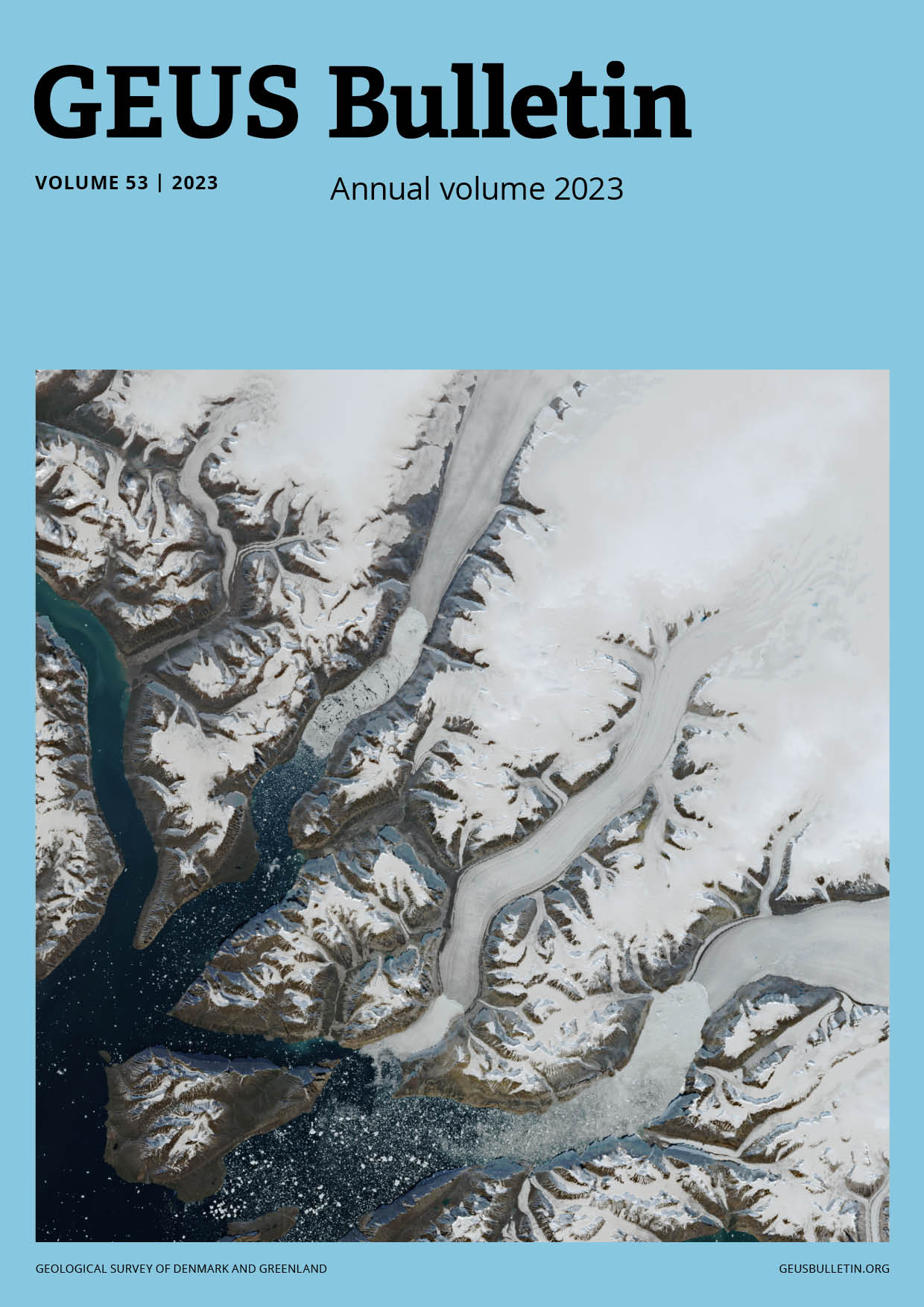
How to Cite
Share
Abstract
Iodine is an essential element for human health, and both high and low iodine intake could have negative health outcomes. The spatial variation of iodine in Danish groundwater has been studied before, but to the author’s knowledge, this is the first time that the temporal variation is characterised. Nationwide data from the Danish groundwater monitoring programme (GRUMO) were analysed between 2011 and 2021, including 2924 samples from 1242 well screens at 893 wells. The sampling frequency varied and so the robust coefficient of variation (rCV) was calculated for 930 (75%) of well screens, and time-series analysis was performed for 23 (2%). Key findings are (1) iodine in Danish groundwater varies over time (0–124%, median = 10%), (2) in one quarter of the well screens rCV exceeds 20% and (3) this variation cannot be attributed solely to analytical uncertainty at 14% of the well screens. The impact of temporal variation of iodine in Danish drinking water of groundwater origin should be evaluated in future exposure or epidemiological studies with respect to the study goal, location and time period. Since the temporal variation could not be quantified over the entire concentration range, monitoring of iodine in Danish groundwater should continue.
How to Cite
Share
Copyright (c) 2023 Denitza D. Voutchkova

This work is licensed under a Creative Commons Attribution 4.0 International License.
Supplementary Files
Downloads
An annual collection of articles submitted to GEUS Bulletin and published throughout 2023. Published online only. This issue is open until the end of 2023.
Cover photo: satellite image is from the European Space Agency’s Copernicus Sentinel data 2023, as featured in Karlsson et al. 2023: A data set of monthly [...]
References
- Andersen, S.B., Petersen, S. & Laurberg, P. 2002: Iodine in drinking water in Denmark is bound in humic substances. European Journal of Endocrinology 147, 663–670. https://doi.org/10.1530/eje.0.1470663
- Andersson, M., Karumbunathan, V. & Zimmermann, M.B. 2012: Global iodine status in 2011 and trends over the past decade. The Journal of Nutrition 142(4), 744–750. https://doi.org/10.3945/jn.111.149393
- Arachchige, C.N.P.G., Prendergast, L.A. & Staudte, R.G. 2022: Robust analogs to the coefficient of variation. Journal of Applied Statistics 49(2), 268–290. https://doi.org/10.1080/02664763.2020.1808599
- Azevedo, F.M., Machamba, A.A.L., Candido, A.C., Pinto, C.A., Lopes, S.O., Macedo, M.D.S., Ribeiro, S.A.V., Priore, S.E. & Franceschini, S.D.C.C. 2023: Correlation between drinking water and iodine status: A systematic review and meta-analysis. Biological Trace Element Research 201(1), 129–138. https://doi.org/10.1007/s12011-022-03127-4
- De Benoist et al. (eds) 2004: Iodine status worldwide: WHO global database on iodine deficiency. Department of Nutrition for Health and Development, World Health Organization. Published report. 48 pp. https://www.who.int/publications/i/item/9241592001 (accessed May 2023)
- EFSA (European Food Safety Authority) 2006: Tolerable upper intake levels for vitamins and minerals. Published report. 480 pp. http://www.efsa.europa.eu/de/ndatopics/docs/ndatolerableuil.pdf (accessed May 2023)
- Farebrother, J., Zimmermann, M.B. & Andersson, M. 2019: Excess iodine intake: sources, assessment, and effects on thyroid function. Annals of the New York Academy of Sciences 1446, 44–65. https://doi.org/10.1111/nyas.14041
- Institute of Medicine 2001: Dietary reference intakes for vitamin A, vitamin K, arsenic, boron, chromium, copper, iodine, iron, manganese, molybdenum, nickel, silicon, vanadium, and zinc. Washington: The National Academies Press. https://doi.org/10.17226/10026
- Laurberg, P., Pedersen, I.B., Carlé, A., Andersen, S., Knudsen, N., Ovesen, L. & Rasmussen, L.B. 2009: The U-shaped curve of iodine intake and thyroid disorders. In: Preedy, V.R., Burrow, G.N. & Watson, R. (eds): Comprehensive handbook of iodine, pp. 449–455. Elsevier. https://doi.org/10.1016/B978-0-12-374135-6.00047-9
- Ma, R. et al. 2022: Deficiency and excess of groundwater iodine and their health associations. Nature Communications 13(1), 7354. https://doi.org/10.1038/s41467-022-35042-6
- Ministry of Environment of Denmark 2011: Total opløst jod. Method data sheet M050. Miljøstyrelsens Referencelaboratorium for Kemiske og Mikrobiologiske Miljømålinger. https://cdnmedia.eurofins.com/Microsites/media/1107/m050_iod_01.pdf (accessed August 2022)
- Ministry of Environment of Denmark 2021: Bekendtgørelse om kvalitetskrav til miljømålinger, BEK nr 2362 af 26/11/2021 (Analysekvalitetsbekendtgørelsen). Miljøministeriet. https://www.retsinformation.dk/eli/lta/2021/2362 (accessed August 2022)
- Pedersen, K.M., Laurberg, P., Nohr, S., Jorgensen, A. & Andersen, S. 1999: Iodine in drinking water varies by more than 100-fold in Denmark. Importance for iodine content of infant formulas. European Journal of Endocrinology 140, 400–403. https://doi.org/10.1530/eje.0.1400400
- R Core Team 2022: R: A language and environment for statistical computing (v. 4.2.1.). R Foundation for Statistical Computing, Austria. https://www.R-project.org/
- Rasmussen, L., Larsen, E. & Ovesen, L. 2000: Iodine content in drinking water and other beverages in Denmark. European Journal of Clinical Nutrition 54, 57–60. https://doi.org/10.1038/sj.ejcn.1600893
- Sharma, N., Karanfil, T. & Westerhoff, P. 2019: Historical and future needs for geospatial iodide occurrence in surface and groundwaters of the United States of America. Environmental Science & Technology Letters 6(7), 379–388. https://doi.org/10.1021/acs.estlett.9b00278
- Thorling, L. 2012: Groundwater sampling (v. 1). Technical guideline. Geological Survey of Denmark and Greenland. 43pp. https://www.geus.dk/media/8324/g02_proevetagning-okt12_uk.pdf (accessed August 2022)
- Thorling, L., Albers, C.N., Hansen, B., Johnsen, A.R., Kazmierczak, J., Mortensen, M.H., Troldborg, L. & Møller, I. 2023: Grundvandsovervågning. Status og udvikling 1989 – 2021. Technical report. 144 pp. Geological Survey of Denmark and Greenland.
- Troldborg, L. 2020: Afgrænsning af de danske grundvandsforekomster: ny afgrænsning og delkarakterisering samt fagligt grundlag for udpegning af drikkevandsforekomster. Copenhagen: Danmarks og Grønlands Geologiske Undersøgelse Rapport 2020/1. 32 pp. https://doi.org/10.22008/gpub/32641
- Voutchkova, D.D., Ernstsen, V., Hansen, B., Sørensen, B.L., Zhang, C. & Kristiansen, S.M. 2014: Assessment of spatial variation in drinking water iodine and its implications for dietary intake: a new conceptual model for Denmark. Science of the Total Environment 493, 432–444. https://doi.org/10.1016/j.scitotenv.2014.06.008
- Wang, B., He, W., Li, Q., Jia, X., Yao, Q., Song, R., Qin, Q. & Zhang, J. 2019: U-shaped relationship between iodine status and thyroid autoimmunity risk in adults. European Journal of Endocrinology 181(3), 255–266. https://doi.org/10.1530/EJE-19-0212
- Wickham, H. 2016: ggplot2: elegant graphics for data analysis (v. 3.4.1). Springer-Verlag. https://ggplot2.tidyverse.org
- Wood, S. 2023: mgcv: Mixed GAM computation vehicle with automatic smoothness estimation (R package v. 1.8-42). https://CRAN.R-project.org/package=mgcv
- WHO (World Health Organization) 2007: Assessment of iodine deficiency disorders and monitoring their elimination: a guide for programme managers (3rd edition). 97 pp. Geneva: World Health Organization.
- WHO & FAOUN (World Health Organization & Food and Agriculture Organization of the United Nations) 2004: vitamin and mineral requirements in human nutrition (2nd edition). 341 pp. Geneva: World Health Organization.









